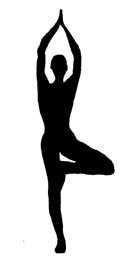|
Types of StretchesAll stretches can be classified into two general categories: Passive=BAD Active=GOOD Passive: Utilizing any force other than that generated by the agonist muscle to force the antagonist (target) muscle beyond its current available relaxed length and beyond its active range of motion (R.O.M.). It is used to override defensive reflexes, which results in autogenic inhibition and desensitized mechano receptors. It is well known that this passive type causes weakness in the targeted muscle. Ballistic: A specific passive type that utilizes inertia to move a body part beyond its active R.O.M. Bouncing or throwing the body into the position. Ballistic is widely accepted to be dangerous because it is difficult to control and very often results in instant injury.
Static: The most common type. A specific, passive type where a muscle is held in the elongated position for a duration of time, usually about 30 seconds.
Isometric: The muscle is first placed in a passive, static, lengthened position and then contracted. This increases the tension in the muscle and amplifies autogenic inhibition. "Proprioceptive Neuromuscular Facilitation"or PNF: A combination of Isometric and Static types, which simply takes advantage of the amplified autogenic inhibition caused by the Isometric type, and follows with an increased Static type. - Lather. Rinse. Repeat.
When we say Stop Stretching, We are referring specifically to the many Passive forms listed above, which rely on autogenic inhibition and induce weakness. (Read more about the risks of passive
stretches.)
Active: Utilizing the agonist muscle to extend the antagonist (target) muscle to the limit of its active R.O.M. Reciprocal inhibition occurs and the active R.O.M. of the antagonist increases. Dynamic: A specific Active type performed through a larger R.O.M. with fluidity and control. Must be carefully monitored or it could become ballistic. 
Yoga: Yoga is far more than just stretching and has a myriad of benefits. Much of the type that is performed in Yoga is of the active and dynamic nature. Most of the detriment of the passive type that may be performed are offset by the strength training inherent in the system.
|

